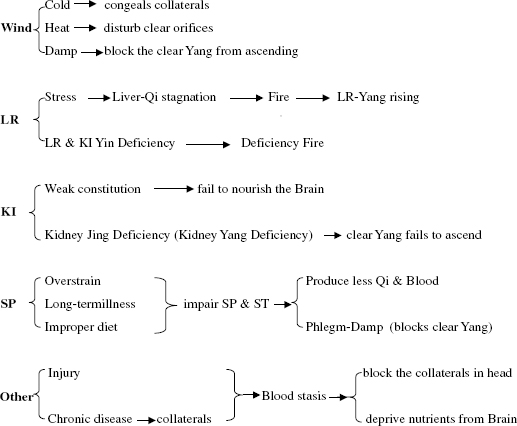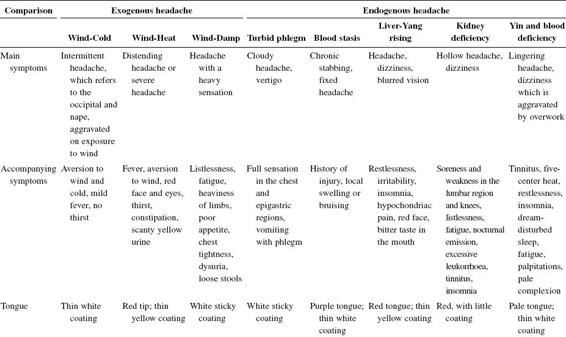The Introduction of Headache
Definition
This is pain of the head associated with various intracranial or extracranial factors. It is a very common symptom of numerous diseases. It is called Tou Tong (“Headache”), Tou Feng (“Head Wind”), or Nao Feng (“Brain Wind”) in TCM (Etiology and pathology of headache).
Western medical classifications
Headache may be categorized into tension headache, vascular (cluster, migraine), and inflammatory headache. It may also be classified into functional headache and organic headache. Functional headache has no clear cause; for instance, migraine or headache during menstruation. Organic headache is usually caused by inflammation or pressure on the meninges, cerebral blood vessels, or cranial nerves; for example, headache due to meningitis, hypertension, trigeminal neuralgia, or an intracranial space-occupying lesion.

Corresponding diseases in CWM
- Hypertension.
- Sinus problems (if frontal headache).
- Neurosis.
- Brain trauma (concussion → blood stasis).
- Infection (especially with high fever).
- Meningitis, tumor.
- Trigeminal neuralgia.
- Eye problems (e.g. glaucoma).
Etiology and Pathology
Exogenous
- Invasion of EPFs:
- Wind-Cold invasion (especially in winter and spring) congeals collaterals, leading to blockage of meridians and collaterals.
- Wind-Heat or Wind-Damp from living conditions or Warm Diseases disturbs or blocks the clear orifices.
Endogenous
(1)Liver
- Emotional stress leads to Liver-Qi stagnation, which could turn into Fire and damage Liver Kidney-Yin → Liver-Yang rising → disturbs the clear orifices → headache.
(2)Kidney
- Weak constitution, Essence deficiency → Blood deficiency → Marrow deficiency fails to nourish the Brain.
- Liver-Yin and Kidney-Yin deficiency → Yang rising disturbs the clear orifices.
- Jing deficiency → deficiency of Yin leads to deficiency of Yang → clear Yang fails to ascend to warm and nourish the Brain.
(3)Spleen
- Improper diet, overstrain, or long-term illness weakens the Spleen → failure to produce Blood and Qi → headache.
- Spleen deficiency (Phlegm-Damp blocks ascending and descending of Qi and Blood).
(4)Blood stasis
- Mostly from head injury (car accident, fall).
- Chronic disease will eventually affect collaterals, causing Blood stasis.
(5)Etiopathology summary
- There are two categories of headache — exogenous and endogenous.
- Wind and Fire (internal or external) are the most frequent pathogens.
- Exogenous headache is usually induced by Wind but often combines with Cold, Heat, or Damp.
- Endogenous headache is mainly related to Liver, Spleen, Kidney, and Blood stasis.
How to Diagnose and differentiate Headache
(see Table 24)
Tips for differentiation
(1)Differentiating between acute and chronic
Acute:
- Mostly caused by EPFs.
- The majority are severe headaches.
- Burning, contracting, throbbing, distending, or heavy kind of pain.
- Pain is consistent.
Chronic:
- Mostly endogenous disorders.
- Dull or hollow pain with dizziness.
- Aggravated by overwork.
- Pain is intermittent.
Exception: Blood stasis can be chronic and is characterized by fixed, severe, and stabbing pain.
(2)Differentiating between excess and deficiency
Excess:
- Exogenous headache is caused by Wind, Damp, Cold, or Heat.
- Endogenous headache includes Liver-Fire headache.
Deficiency:
- Usually affects people with a weak constitution.
- Liver-Yin or Kidney-Yin deficiency.
- Kidney-Essence deficiency.


Mixed:
- Headaches due to turbid Phlegm and Blood stasis usually have the nature of root deficiency with branch excess.
(3)Differentiating the locations
- Taiyang headache — occipital headache that refers to the neck.
- Yangming headache — frontal headache that refers to the eye socket.
- Shaoyang headache — temple headache that refers to the ear.
- Jueyin headache — vertex headache that may refer to the eye socket.
- GV Meridian headache — vertex headache.
- Shaoyin headache — pain deep inside the head.
The Treatment of Headache
Principle of treatment
(1)Acute (usually excess)
- Remove pathogenic Qi.
- Disperse Wind, plus:
- Dispel Cold.
- Clear Heat.
- Remove Damp.
(2)Chronic (usually deficiency)
- Tonify Zheng Qi through nourishing Liver-Yin and Kidney-Yin, or tonify Yin and Blood.
(3)Mixed
- Tonify plus reduce.
Acupuncture
(1)Basic points
- GB 20 and GV 20, Taiyang, LI 4, LU 7, SI 3, Ashi points.
(2)Exogenous headache
- The three Yang meridians yield the main points.
- Reducing method and moxa for the Wind-Cold pattern.
(3)Turbid phlegm
- CV and ST Meridians as the main points.
- Reducing method.
- Nausea → PC 6.
(4)Blood stasis
- LI, ST, SP, and Ashi points as the main points.
- Tonifying plus reducing method.
(5)Liver-Yang rising
- LR and GB as the main points.
- Reducing method.
- May also tonify Foot Shaoyin.
(6)Kidney deficiency
- Kidney Meridian and Back Shu points as the main points.
- Tonifying method.
(7)Yin and blood deficiency
- GV, ST, SP Meridians and Back Shu points as the main points.
- Use the tonifying method, and combine it with moxa.
(8)Modification based on location
Frontal headache:
- GV 23, 24
- GB 14
- BL 2
- ST 8, 41, 44
- Yintang
- LI 4
Temple headache:
- GB 4, 8, 41
- TE 20, 5
Occipital headache:
- GV 17
- BL 9, 10, 62, 65
- SI 3
Vertex headache:
- GV 20
- LR 3
- Sishencong
Shaoyin headache:
- KI 1
- GV 20
- KI 3
Auricular acupuncture
- Occipital
- Forehead
- Temple
- Brain
- Shenmen
- Liver
- Subcortex
- Stomach
- Gall Bladder
- Urinary bladder
Three or four points each time; retain for 20–30 min or apply ear seeds. Bleed veins on the back of the ear or the ear apex for severe headache.
Plum blossom needle
Best for exogenous headache, as well as headaches due to Liver-Yang rising or Blood stasis.
- Taiyang
- Yintang
- Ashi points
Apply cupping after tapping with the plum blossom needle
Magnetic therapy
- ST 8
- Taiyang
- GB 20
- Anmian
- Ashi points
Two to four points each time. Change the magnetic beads every two days.
Scalp
- Sensory area, upper 1/5.
- Blood vessel dilation and contraction area, upper 1/2.
Electrostimulation for 15–20 min.

